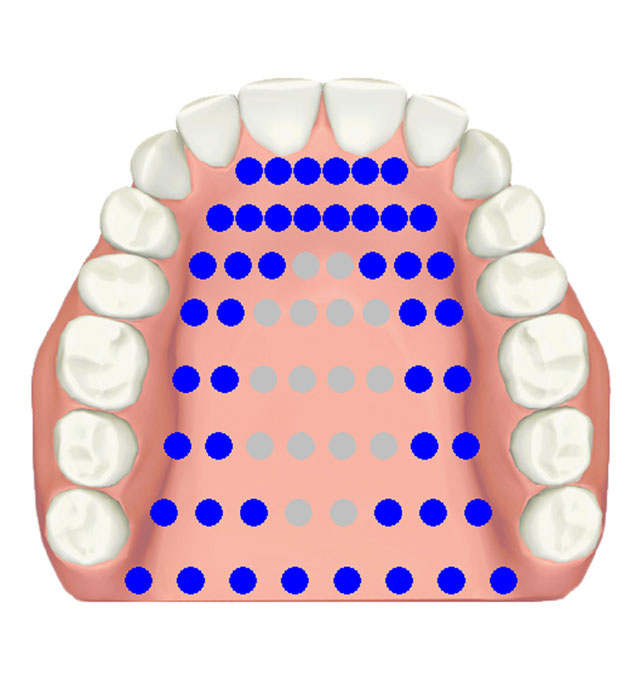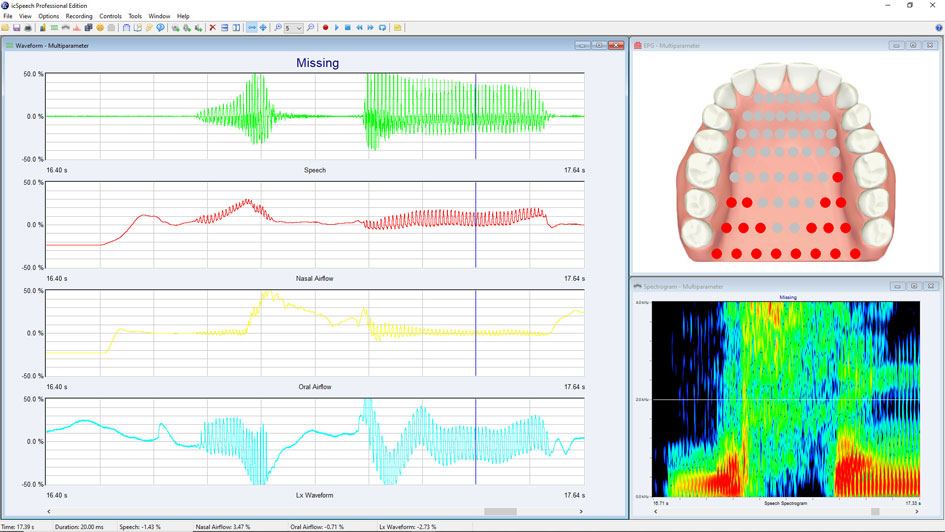Electropalatography
Portable electropalatography (EPG) system
LinguaGraph is a portable electropalatography (EPG) system that monitors tongue contact with the hard-palate during speech. Electropalatography provides direct articulatory information that can be used to study or improve articulation patterns.
How electropalatography works
Electropalatography determines tongue-palate contact by using a special artificial palate that contains 62 electrodes embedded on its lingual surface. A small electrical signal is sent to the user, which is conducted through the tongue to any touched electrodes. These tongue-palate contact patterns are then displayed on a computer screen.

Electropalatography palate

The LinguaGraph electropalatography system is compatible with the Reading EPG palate design. Each palate, sold separately, is custom-made for each user and simply clips to the upper teeth. In order to create an EPG palate, a qualified dentist must first take an impression of the upper palate and teeth. A plaster model is then created from the impression and sent directly to us for EPG palate manufacture.
Get QuoteElectropalatography palate kit

Electropalatography palate kits enable orthodontic technologists to manufacture EPG palates locally. Each kit contains:
- 62 silver electrodes with attached leads.
- EPG Connector board.
- EPG Connector board cover.
- Heat shrink tubing.
- Instruction manual.
Electropalatography software options
LinguaView

LinguaView is easy-to-use Windows software that provides an ideal introduction to electropalatography. Features include:
- Preview tongue-palate contact in real-time
- Record tongue-palate contact and audio
- Playback tongue-palate contact and audio
- Tongue-palate contact template library
- Tongue-palate contact template editor
- Create tongue-palate contact videos
- Anatomical or classic palatograph displays
- Compatible with videoconferencing software for remote operation
- Windows 10, 8, 7 and Vista compatible
- 10 user license
LinguaView is language independent, and provides direct articulatory information wherever the tongue touches the hard palate. The tongue-palate contact patterns below represent typical lingual consonants produced by normal English speakers:

Alveolar Stop /t/, /d/, /n/

Alveolar Grooved /z/, /s/

Post-Alveolar Grooved /ʃ/, /ʒ/

Double Alveolar-Velar /tk/, /kt/, /kl/

Velar Stop /k/, /g/, /ŋ/

Apical /l/
LinguaView 3D
LinguaView 3D uses state-of-the-art computer animation and 3D modelling techniques to illustrate where the tongue touches the hard-palate during speech. The 3D model consists of the tongue, hard palate, teeth and lower jaw. The transparency of these articulators can be adjusted to reveal hidden structures, and the model can be rotated 360°.

LinguaView 3D is language independent, and provides direct articulatory information wherever the tongue touches the hard palate. The tongue-palate contact patterns below represent typical lingual consonants produced by normal English speakers:

Alveolar Stop /t/, /d/, /n/

Alveolar Grooved /z/, /s/

Post-Alveolar Grooved /ʃ/, /ʒ/

Double Alveolar-Velar /tk/, /kt/, /kl/

Velar Stop /k/, /g/, /ŋ/

Apical /l/
Features include:
- Preview 3D tongue-palate contact in real-time
- Record 3D tongue-palate contact at up to 200 FPS with fully synchronised audio
- 3D tongue-palate contact template library
- 3D tongue-palate contact template editor
- 360° photorealistic and stylised views
- Upper and lower jaw with adjustable transparency
- File format compatible with icSpeech Professional Edition
- Windows 64-bit 10 and 8 compatible
icSpeech Professional Edition
LinguaGraph is also compatible with the multiparameter speech visualisation and analysis package icSpeech Professional Edition, which supports a wealth of additional features.

Features include:
- Multi-channel EPG
- Anatomical or classic palatograph displays
- Waveform displays
- Spectrogram displays
- EPG Games
- Extensive lingual parameters and analysis
- EPG data export facility
- EPG Template matching
- Recorder with picture & word prompting
- Combines EPG with acoustic, airflow, voicing and video data
- Windows 10, 8, 7 and Vista compatible
Electropalatography specification
| Supported operating systems | Windows 10, 8, 7 or Vista |
|---|---|
| Supported computers | Desktop, laptop, tablet |
| Connectivity | USB 1.0, 2.0, 3.0 |
| Power | USB bus powered |
| Palate type | Reading, 62 electrode |
| Resolution | 62 electrode |
| Sensitivity | Manual adjustment |
| Maximum frame rate | 200 frames per second |
| Minimum frame rate | 50 frames per second |
Get electropalatography quote
The electropalatography package includes:
- LinguaGraph EPG unit
- Carry case
- Neck strap
- Wrist strap
- Handgrip
- Signal cord
- 2 meter locking USB cable
- User manual
- 12 months guarantee
- LinguaView (optional)
- LinguaView 3D (optional)
- icSpeech Professional Edition (optional)
